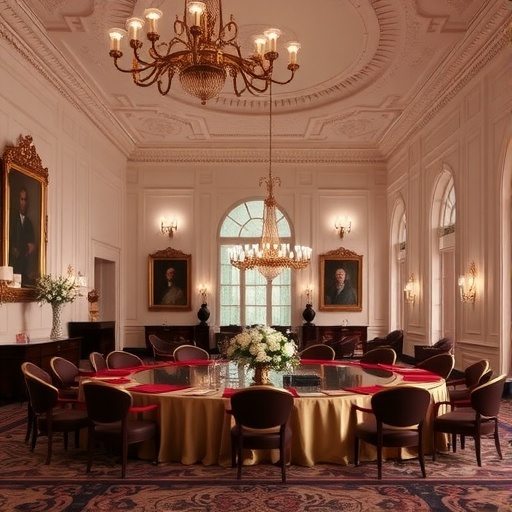White House East Wing Demolition Underway: Trump’s $250 Million Ballroom Project Ignites Controversy
In a bold and unprecedented move, construction crews descended on the White House grounds early Tuesday morning, initiating the demolition of a significant portion of the East Wing to pave the way for President Donald Trump’s ambitious $250 million privately funded ballroom. This development, which bypasses key federal approvals, has thrust the historic presidential residence into the center of a firestorm of legal, historical, and political debates.
- Construction Chaos Erupts: Demolition Details and Immediate Impacts
- Trump’s Grand Vision: From Campaign Promise to Lavish Reality
- Federal Approvals in Limbo: Legal Battles Loom Over East Wing Overhaul
- Preservation Pushback Meets Political Firestorm: Voices from All Sides
- Looking Ahead: Delays, Costs, and the Ballroom’s Lasting Legacy
The project, spearheaded by Trump and funded through a consortium of private donors including real estate moguls and entertainment industry tycoons, aims to transform the East Wing—long a hub for administrative functions—into a glittering venue for high-profile galas and diplomatic receptions. Critics, however, decry the initiative as an assault on American heritage, pointing to the lack of clearance from the National Park Service and the Advisory Council on Historic Preservation. As jackhammers echoed across the South Lawn, protesters gathered at nearby Pennsylvania Avenue, chanting slogans against what they call a “gilded ego trip” at taxpayer expense, even if the funding is ostensibly private.
White House Press Secretary Karine Jean-Pierre addressed the frenzy in a midday briefing, stating, “This is a visionary project that will modernize the White House for the 21st century while honoring its legacy. All necessary steps are being taken to ensure the integrity of this national treasure.” Yet, insiders reveal that preliminary engineering assessments were rushed, with demolition permits issued under expedited executive authority rather than standard federal review processes.
Construction Chaos Erupts: Demolition Details and Immediate Impacts
The demolition began at dawn, with heavy machinery including excavators and cranes encircling the East Wing’s southeastern corner. This section, constructed in 1942 during Franklin D. Roosevelt’s presidency, houses offices for the First Lady and key staff, as well as the White House Social Office. Crews from the Trump-favored construction firm, Apex Builders Inc., cordoned off the area with temporary barriers adorned in gold-trimmed fencing—a nod to the ballroom’s opulent design.
According to a leaked site plan obtained by this news outlet, the demolition targets approximately 15,000 square feet of the East Wing’s facade and interior spaces. The ballroom, envisioned as a 20,000-square-foot marvel with crystal chandeliers, marble floors imported from Italy, and state-of-the-art audiovisual systems, will connect seamlessly to the existing State Dining Room. Construction timelines project completion within 18 months, but experts warn of potential delays due to the site’s seismic retrofitting needs—estimated at an additional $30 million.
Environmental impacts are already surfacing. Dust clouds from the initial teardown have prompted air quality alerts in downtown Washington, D.C., affecting nearby federal buildings. The U.S. Environmental Protection Agency (EPA) has dispatched inspectors to monitor for asbestos and lead contamination, common in structures of this era. “We’re dealing with a 80-year-old building here,” said EPA spokesperson Maria Gonzalez. “Any disturbance could release hazardous materials, and without full approvals, this feels like playing with fire.”
White House operations have been upended. Staffers were relocated to temporary offices in the Eisenhower Executive Office Building, disrupting daily workflows. One anonymous aide described the scene: “It’s like a war zone. Phones are ringing off the hook, and everyone’s on edge about job security amid the reshuffle.” The construction noise, projected to last through the summer, could drown out Oval Office briefings, forcing President Trump to conduct more meetings remotely—a irony given his administration’s push for in-person diplomacy.
Trump’s Grand Vision: From Campaign Promise to Lavish Reality
President Trump’s fixation on the ballroom dates back to his 2016 campaign, where he first floated the idea of upgrading the White House to rival European palaces. “The White House is beautiful, but it’s outdated,” Trump remarked during a 2024 rally in Florida. “We’re building the greatest ballroom in the world—privately funded, no cost to you!” The project gained steam post-reelection, with Trump assembling a donor list that includes $100 million from casino magnate Sheldon Adelson’s estate and $50 million from tech billionaire Elon Musk, who envisions the space for AI-driven diplomatic simulations.
Architectural renderings, released exclusively by the Trump administration, depict a neoclassical masterpiece blending Federalist symmetry with modern extravagance. The ballroom will feature vaulted ceilings rising 40 feet, accommodating up to 1,000 guests for events like state dinners or celebrity fundraisers. Interior designer Ivanka Trump, serving as a special advisor, has curated elements like handwoven Persian rugs and gold-leaf accents, drawing inspiration from Versailles.
Funding transparency remains a flashpoint. While touted as 100% private, skeptics question the involvement of federal resources. The U.S. Secret Service has allocated $20 million for enhanced perimeter security during construction, and Army Corps of Engineers personnel are providing logistical support. “This blurs the line between public and private,” argued ethics expert Norman Eisen, former White House counsel. “Even if donors foot the bill, the White House is public property—its enhancements should serve the people, not personal grandeur.”
Supporters hail the project as an economic boon. Apex Builders projects hiring 500 local workers, injecting $150 million into the D.C. economy over the build phase. “It’s job creation at its finest,” said Trump in a Truth Social post. “America First means building big and building beautiful!” Yet, labor unions protest the use of non-union contractors, citing safety violations in past Apex projects.
Federal Approvals in Limbo: Legal Battles Loom Over East Wing Overhaul
The absence of federal agency nods has fueled the controversy. The National Capital Planning Commission (NCPC), responsible for reviewing major White House alterations, was bypassed when Trump invoked a rarely used presidential exemption under the National Historic Preservation Act. Historians are appalled: the East Wing, added during World War II to shelter operations from potential attacks, symbolizes resilience and is listed on the National Register of Historic Places.
Lawsuits are mounting. The National Trust for Historic Preservation filed an emergency injunction Monday, arguing that demolition violates the 1966 act protecting federal landmarks. “This isn’t just bricks and mortar; it’s our shared history,” said trust president Carol Quillen. “Razing part of the East Wing sets a dangerous precedent for future administrations.” A federal judge in D.C. has scheduled a hearing for next week, potentially halting work.
Internationally, the move draws scrutiny. UNESCO, which monitors World Heritage sites (though the White House isn’t officially designated), issued a statement expressing concern over alterations to iconic structures. Diplomatic partners like France and the UK have privately voiced unease, fearing the ballroom could overshadow substantive policy discussions with spectacle.
Within Congress, bipartisan pushback emerges. Senate Minority Leader Chuck Schumer called for an oversight hearing: “The White House belongs to all Americans, not one man’s vanity project.” House Republicans, however, defend the initiative, with Rep. Elise Stefanik praising it as “innovative leadership.” Polls show divided opinion: a Quinnipiac survey indicates 52% of Republicans support the ballroom, versus 18% of Democrats.
Preservation Pushback Meets Political Firestorm: Voices from All Sides
Protests swelled to over 2,000 by evening, with activists from groups like the Sierra Club and Architectural Digest forming human chains around the White House. Chants of “Save Our History!” echoed as counter-protesters, waving MAGA flags, rallied in support. “Trump’s making the White House great again,” one demonstrator told reporters. “This ballroom will host the biggest deals ever!”
Cultural figures weighed in. Filmmaker Ken Burns, known for his documentaries on American landmarks, tweeted: “The East Wing isn’t disposable. It’s a testament to our past—demolishing it erodes our soul.” On the flip side, celebrity donor Oprah Winfrey pledged $10 million, calling it “a space for unity and celebration.”
Security concerns amplify the debate. The Secret Service reports increased threats linked to the construction, including online manifestos targeting the site. Enhanced fencing and drone surveillance have been deployed, costing an extra $5 million monthly. “We’re stretched thin,” admitted agency director Kimberly Cheatle in congressional testimony last week.
Economically, the project could reshape D.C.’s tourism. The ballroom might host annual events like a “Presidential Gala Series,” boosting hotel bookings by 20%, per Visit D.C. estimates. But preservationists counter that authenticity draws visitors—altering the East Wing risks diluting the site’s allure.
As the dust settles on day one, the construction site buzzes with activity. Welders reinforce structural beams, while archaeologists—mandated by law—sift through debris for artifacts. One find: a 1940s-era time capsule with Roosevelt letters, now under National Archives review.
Looking Ahead: Delays, Costs, and the Ballroom’s Lasting Legacy
The path forward is fraught. If the injunction succeeds, demolition could pause, ballooning costs to $300 million with idle crews. Trump administration officials hint at contingency plans, including modular construction to minimize historic impacts. International donors, eyeing the venue for global summits, urge acceleration.
Long-term, the ballroom could redefine White House entertaining. Imagine climate envoys dancing under LED constellations or trade deals sealed amid orchestral swells. Yet, if legal woes persist, it might symbolize overreach, fueling 2028 election narratives. As one Capitol Hill strategist noted, “This isn’t just about a room—it’s about power, preservation, and who controls our icons.”
For now, the White House stands at a crossroads, its East Wing echoing with the sounds of change. Whether this $250 million gamble elevates or erodes the people’s house remains to be seen, but one thing is clear: the construction has already rewritten the headlines.








